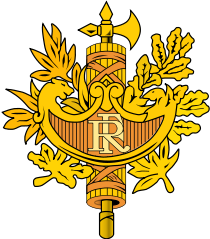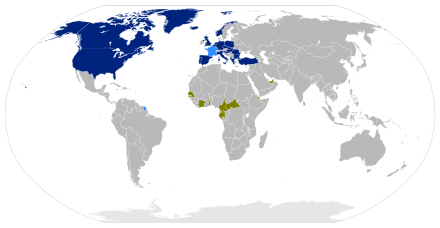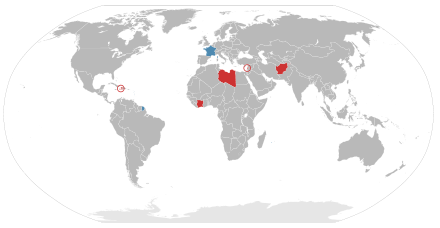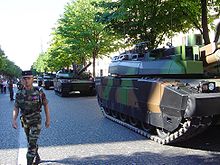- French Armed Forces
-
French Armed Forces
Armées françaises
Coat of Arms of the French Republic (unofficial)Service branches Armée de Terre
Marine Nationale
Armée de l'Air
Gendarmerie NationaleLeadership Commander-in-Chief President Nicolas Sarkozy Minister of Defence Gérard Longuet Chief of staff Admiral Édouard Guillaud Manpower Military age 17 years of age with consent for voluntary military service (2001) Available for
military service13,676,509 (2005 est.), age 15–49 Fit for
military service11,262,661 (2005 est.), age 15–49 Reaching military
age annually389,204 (2005 est.) Active personnel 219,000 regulars
105,389 gendarmerie
Reserve personnel 32,750 civilian reserves
419,000 regular reserves(2006)
Expenditures Budget €44.788 billion[1] (2010)
(this figure excludes the Gendarmerie)Percent of GDP 2.1% (2009)[2] Related articles History Military History of France  Defence agreements of France in 2008:
Defence agreements of France in 2008: FranceOther NATO membersOther bilateral defence agreements, with Cameroon, the Central African Republic, Comoros, Côte d'Ivoire, Djibouti, the United Arab Emirates[3], Gabon, Kuwait, Qatar, Senegal and Togo[4]
FranceOther NATO membersOther bilateral defence agreements, with Cameroon, the Central African Republic, Comoros, Côte d'Ivoire, Djibouti, the United Arab Emirates[3], Gabon, Kuwait, Qatar, Senegal and Togo[4]The French Armed Forces encompass the French Army, the French Navy, the French Air Force and the National Gendarmerie. The President of the Republic heads the armed forces, with the title "chef des armées" ("chief of the military forces"). The President is the supreme authority for military matters and is the sole official who can order a nuclear strike. The French military has, as some of its primary objectives, the defence of national territory, the protection of French interests abroad, and the maintenance of global stability.
Contents
International stance
French military doctrine is based on the concepts of national independence, nuclear deterrence (see Force de frappe), and military self-sufficiency. France is a charter member of NATO, and has worked actively with its allies to adapt NATO—internally and externally—to the post-Cold War environment. In December 1995, France announced that it would increase its participation in NATO's military wing, including the Military Committee (France withdrew from NATO's military bodies in 1966 whilst remaining full participants in the Organisation's political Councils). France remains a firm supporter of the Organisation for Security and Co-operation in Europe and other cooperative efforts. Paris hosted the May 1997 NATO-Russia Summit which sought the signing of the Founding Act on Mutual Relations, Cooperation and Security.
Outside of NATO, France has actively and heavily participated in both coalition and unilateral peacekeeping efforts in Africa, the Middle East, and the Balkans, frequently taking a lead role in these operations. France has undertaken a major restructuring to develop a professional military that will be smaller, more rapidly deployable, and better tailored for operations outside of mainland France. Key elements of the restructuring include: reducing personnel, bases and headquarters, and rationalistion of equipment and the armaments industry.
Since the end of the Cold War, France has placed a high priority on arms control and non-proliferation. French Nuclear testing in the Pacific, and the Sinking of the Rainbow Warrior strained French relations with its Allies, South Pacific states (namely New Zealand), and world opinion. France agreed to the Nuclear Non-Proliferation Treaty in 1992 and supported its indefinite extension in 1995. After conducting a controversial final series of six nuclear tests on Mururoa in the South Pacific, the French signed the Comprehensive Test Ban Treaty in 1996. Since then, France has implemented a moratorium on the production, export, and use of anti-personnel landmines and supports negotiations leading toward a universal ban. The French are key players in the adaptation of the Treaty on Conventional Armed Forces in Europe to the new strategic environment.
France remains an active participant in: the major programs to restrict the transfer of technologies that could lead to the proliferation of weapons of mass destruction: the Nuclear Suppliers Group, the Australia Group (for chemical and biological weapons), and the Missile Technology Control Regime. France has also signed and ratified the Chemical Weapons Convention.
See also: France and weapons of mass destruction2008 reforms
On 31 July 2007, President Nicolas Sarkozy ordered M. Jean-Claude Mallet, a member of the Council of State, to head up a thirty-five member commission charged with a wide-ranging review of French defence. The commission issued its White Paper in early 2008.[5] Acting upon its recommendations, President Sarkozy began making radical changes in French defence policy and structures starting in the summer of 2008. In keeping with post-Cold War changes in European politics and power structures, the French military's traditional focus on territorial defence will be redirected to meet the challenges of a global threat environment. Under the reorganisation, the identification and destruction of terrorist networks both in metropolitan France and in francophone Africa will be the primary task of the French military. Redundant military bases will be closed and new weapons systems projects put on hold to finance the restructuring and global deployment of intervention forces. In a historic change, Sarkozy furthermore has declared that France "will now participate fully in NATO," four decades after former French president General Charles de Gaulle withdrew from the alliance's command structure and ordered American troops off French soil.[6]
Recent operations
 Recent OPEX:
Recent OPEX:
- Operation Licorne in Côte d'Ivoire (under UN mandate)
- Contribution to the United Nations Stabilisation Mission in Haiti
- International Security Assistance Force in Afghanistan (under UN mandate)
- Contribution to the United Nations Interim Force in Lebanon; Opération Baliste
- 2011 military intervention in Libya; Opération HarmattanThere are currently 36,000 French troops deployed in foreign territories—such operations are known as "OPEX" for Opérations Extérieures ("External Operations").
Along with the United States and other countries, France provides troops for the United Nations force stationed in Haiti following the 2004 Haiti rebellion. France has sent troops, especially special forces, into Afghanistan to help the United States and NATO forces fight the remains of the Taliban and Al Qaeda. In Opération Licorne a force of a few thousand French soldiers is stationed in Côte d'Ivoire (Ivory Coast) on a UN peacekeeping mission. These troops were initially sent under the terms of a mutual protection pact between France and the Côte d'Ivoire, but the mission has since evolved into the current UN peacekeeping operation. The French Armed Forces have also played a leading role in the ongoing UN peacekeeping mission along the Lebanon-Israel border as part of the cease-fire agreement that brought the 2006 Lebanon War to an end. Currently, France has 2,000 army personnel deployed along the border, including infantry, armour, artillery and air defence. There are also naval and air personnel deployed offshore.
The French Joint Force and Training Headquarters (L'Etat-Major Interarmees de Force et d'Entrainment) at Air Base 110 near Creil maintains the ability to command a medium or large-scale international operation, and runs exercises .[7]
In 2011, from 19 March, France participated, and is currently participating in the enforcement of a no-fly zone over northern Libya, during the Libyan Civil war, in order to prevent forces loyal to Muammar Gaddafi from carrying out air attacks on Anti-Gaddafi forces. This operation was known as Opération Harmattan and was part of France's involvement in the conflict in the NATO-led coalition, enforcing UN Security Council Resolution 1973.
Organisation
The titular head of the French armed forces is the President of the Republic, in his role as Chef des Armées—the President is thus Commander-in-Chief of French forces. However, the Constitution puts civil and military government forces at the disposal of the government (the executive cabinet of ministers, who are not necessarily of the same political side as the president). The Minister of Defence (as of 2007, Gérard Longuet) oversees the military's funding, procurement and operations.
The French armed forces are divided into four branches:
- Army (Armée de Terre), including:
- Infantry (Infanterie)
- Chasseurs Alpins (mountain infantry)
- Armoured Cavalry (Arme Blindée Cavalerie)
- Artillery (Artillerie)
- Légion Étrangère (Foreign Legion) (infantry, cavalry, engineers)
- Troupes de Marine ('La Coloniale') (Marines troop) (infantry, cavalry, paratroopers, artillery)
- Army Light Aviation (Aviation Légére de l'Armée de Terre—ALAT)
- Engineers (Génie) including the Paris Fire Brigade
- Signals (Transmissions)
- Transport and logistics (Train)
- Supply (Matériel)
- Infantry (Infanterie)
- Navy (Marine Nationale), including:
- Naval Air
- French Submarine Forces
- Fusiliers Marins (Sailor Riflemen) (naval ground troops) and naval commandos
- the Marseille Marine Fire Battalion
- Air Force (Armée de l'Air) including:
- territorial Air Defence
- air fusiliers (air force ground troops)
- Commando parachutiste de l'air ( CPA 10 "Special force", CPA 20 "TACP" and CPA 30 " Resco" ) are specialized air force ground troops, and only CPA 10 is special force.
- Gendarmerie (Gendarmerie Nationale), a military police force which serves for the most part as a rural and general purpose police force, including:
- Gendarmerie Départementale (GD) (territorial police, criminal investigation ...)
- Gendarmerie Mobile (GM) (anti-riot units, counter-terrorism group (GIGN), foreign police assistance ...)
- Garde républicaine
- Gendarmerie des Transports Aériens (Airports security, traffic control ...)
- Gendarmerie de l'Air (Air Force security and provosts ...)
- Gendarmerie Maritime (Coast guards, Naval provosts ...)
It also include the following services:
- SGA (Eng: Secretariat general de l'administration = administration and construction).
- Direction Générale de l'Armement (Eng: General Weaponry Directorate) is the French defence procurement agency (a mixed military/civilian service) that includes the former Direction des Constructions Navales. It also manages a number of engineering schools: the École Polytechnique, École Nationale Supérieure de Techniques Avancées, SUPAERO, the ENSICA (SUPAERO and the ENSICA merged in 2007 to create ISAE) and the ENSTA Bretagne;
- Health service of the armies (Eng: Service de Santé des Armées) operates a number of military hospitals.
- Fuel Services (Eng: Service des Essences des Armées = Army Fuels Service).
Personnel
The combined number of military personnel is 357,139, however, 105,389 (2006)[8] belong to the National Gendarmerie and, thus, used in everyday law enforcement operations within France (elements of the Gendarmerie are, however, present in all French external operations, providing specialised law enforcement troops/military police). This leaves the main body of the French Armed Forces with a total of 219,000 regulars and 32,750 civilian reserves, broken down as below;[9][10][11]
The regular French Armed Forces;
- French Air Force: 51,500 regulars
- French Navy: 37,000 regulars
- French Army: 123,100 regulars and 7,400 Foreign Legion
The civilian reserves of the French Armed Forces;
- French Air Force: 7,400 civilian reserves
- French Navy: 7,000 civilian reserves
- French Army: 18,350 civilian reserves
In addition the French Armed Forces have approximately 419,000 reserves.
Historically, France relied a great deal on conscription to provide manpower for its military, in addition to a minority of professional career soldiers. Following the Algerian War, the use of non-volunteer draftees in foreign operations was ended; if their unit was called up for duty in war zones, draftees were offered the choice between requesting a transfer to another unit or volunteering for the active mission. In 1996, President Jacques Chirac's government announced the end of conscription and in 2001, conscription formally was ended. Young people must still, however, register for possible conscription (should the situation call for it). A recent[when?] change is that women must now register as well.
Equipment
Main article: Modern equipment and uniform of the French Army- The standard assault rifle is the FAMAS.
- The standard pistol is the PAMAS, a version of the Beretta 92 produced under licence.
- Nexter provides heavy armoured vehicles, while Dassault Aviation is the source of military aircraft.
-
AMX 56 Leclerc Tank of Armée de terre
-
The Charles de Gaulle, the nuclear aircraft carrier of Marine nationale
See also
- Ranks in the French Army
- Ranks in the French Navy
- Ranks in the French Air Force
- Bastille Day Military Parade
- Franco-British Defence and Security Cooperation Treaty and Downing Street Declaration
References
- ^ http://milexdata.sipri.org/
- ^ Defence Expenditures of NATO Countries (1985-2009)
- ^ "French Military base in Abu Dhabi, United Arab Emirates". Defence Aviation. 2009-05-28. http://www.defenceaviation.com/2009/05/french-military-base-in-abu-dhabi.html. Retrieved 2009-06-02.
- ^ Que dit le Livre blanc sur les accords de défense ?, Ministry of Defence
- ^ Official Presidential Website, Letter of Engagement to M. Jean-Claude Mallet, 31 July 2007
- ^ Jim Hoagland, "France's Whirlwind of Change", Real Clear Politics, 18 June 2008 [1]
- ^ http://www.defense.gouv.fr/ema/commandement/organismes_et_directions_interarmees/emia_fe/emia_fe
- ^ http://www.defense.gouv.fr/gendarmerie/decouverte/moyens/effectifs/repartition/repartition_des_effectifs Répartition des effectifs
- ^ http://www.defense.gouv.fr/air/presentation/chiffres-cles/chiffres-cles
- ^ http://www.defense.gouv.fr/english/navy/forces
- ^ http://www.defense.gouv.fr/terre/presentation/directions-commandements-et-centres/ressources-humaines/direction-des-ressources-humaines-de-l-armee-de-terre
External links
- Official site of the French Ministry of Defence
- French Military Strategy and NATO Reintegration—Council on Foreign Relations
- French Army rank insignia
French Army French Navy French Air Force Armoured cavalry Artillery, transport and combat engineering French Army Light Aviation AMX 30 - ERC 90 Sagaie - AMX 10 RC
Leclerc - AMX-10P - AuF1
VAB - VBL - VBCIAuF1 - MLRS - TRF1
Caesar - AMX 30 Pluton - Peugeot P4
ACMAT - EBG - EFA - DNGAlouette III - Gazelle - Puma
Super Puma- Tiger - Fennec
Cougar - NH90Naval Action Force Strategic Oceanic Force Naval aviation Jeanne d'Arc - BATRAL- A69 - Tourville - Cassard - Floréal - La Fayette - Charles-de-Gaulle - Foudre - Mistral - Horizon - Aquitaine - PA 2 Rubis -Suffren - Le Triomphant
Le Vigilant - Le RedoutableBreguet Atlantic - Super Étendard - Hawkeye
Falcon 10 - Rafale - Super Frelon
Dauphin - Panther - Lynx - NH90Aerial refueling and Transport aircraft Helicopter and Surface-to-air missile Fighter aircraft TBM-700 - Falcon 900
KC-135 - A330
Transall - C-130 - A400MFennec - Cougar
Puma - Gazelle
Crotale - MistralMirage IV - Mirage F1
Jaguar - Alpha Jet
Mirage 2000 - RafaleNorth Atlantic Treaty Organization (NATO) History 
Structure Members Militaries of the member states of the European Union Military of Europe Sovereign
states- Albania
- Andorra
- Armenia
- Austria
- Azerbaijan
- Belarus
- Belgium
- Bosnia and Herzegovina
- Bulgaria
- Croatia
- Cyprus
- Czech Republic
- Denmark
- Estonia
- Finland
- France
- Georgia
- Germany
- Greece
- Hungary
- Iceland
- Ireland
- Italy
- Kazakhstan
- Latvia
- Liechtenstein
- Lithuania
- Luxembourg
- Macedonia
- Malta
- Moldova
- Monaco
- Montenegro
- Netherlands
- Norway
- Poland
- Portugal
- Romania
- Russia
- San Marino
- Serbia
- Slovakia
- Slovenia
- Spain
- Sweden
- Switzerland
- Turkey
- Ukraine
- United Kingdom
- Vatican City
States with limited
recognition- Abkhazia
- Kosovo
- Nagorno-Karabakh
- Northern Cyprus
- South Ossetia
- Transnistria
Other entities - European Union
- Sovereign Military Order of Malta
Categories: - Army (Armée de Terre), including:
Wikimedia Foundation. 2010.




